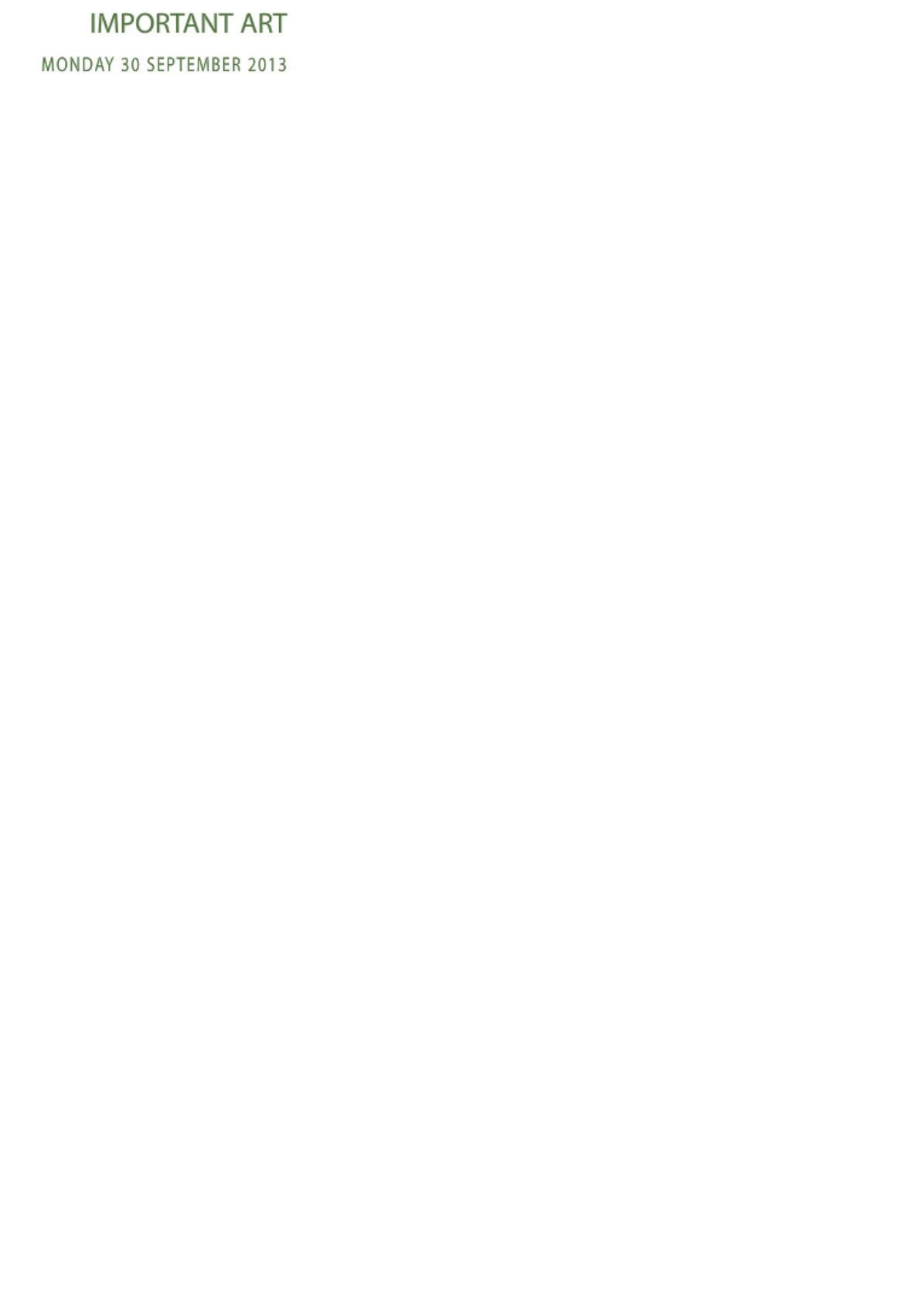
46
62
Paul Henry
KEEL VILLAGE,
oil on canvas
signed lower le
18 by 20in. (45.
Provenance:
Private collecti
Adam’s, 28 May
Whence purcha
Exhibited:
‘Paintings by M
Russell (AE), Lei
Literature:
Kennedy, S.B.,
P
London, 2007, c
In original Waddi
The form of the si
signify that this c
August 1911.The
seen from the hig
the middle distan
moderate impast
painting at this ti
blues and greys t
influence that wo
foreground, is ch
composition of t
is larger, althoug
excitement at his
Dr SB Kennedy
February 2013
!
50,000-
!
70,0
WHYTES
SINCE 1783
,
Lot 33
Sir John Lavery RA RSA RHA (1856-1941)
THE LADY PARMOOR, 1919
oil on canvas signed lower right; signed, titled and dated on reverse 30 by 25in. (76.20 by
63.50cm)
Provenance: Lord and Lady Parmoor by descent;1 Adamʼs, 11 December 1990, lot 73; where
purchased and by descent to the previous owners; Adamʼs, 6 December 2010, lot 97; Private
collection
Exhibited: Royal Academy, London, 1920, catalogue no. 159
With the cessation of hostilities on the Western Front in November 1918, Lavery was much in
demand. Not yet released from his commission as an Official War Artist, he had a large
commemorative oil painting depicting the surrender of the German Navy to complete. He was
also given the additional task to tour supply depots and hospitals in Northern France before they
were dismantled and record womenʼs work behind the lines.While his diary quickly filled with
portrait commissions, normal everyday life in the busy studio in Cromwell Place, South
Kensington, did not resume until after his holiday in February 1919 at Baron dʼErlangerʼs villa at
Sidi-bu-Said on the bay of Tunis.
Back for the start of the London Season, sittings began with feverish intensity and within the year
he completed portraits of Duff Cooper, Lady Diana Manners, Flora Lion (sold in these rooms, 19
February 2007, lot 93 for €24,000), Lord Londonderry, the aviator, Sir John Alcock, and other
prominent society figures. Among these was Marion Emily Ellis, who in July of that year became
the second Baroness Parmoor.The portrait may indeed have been painted as a wedding gift from
Charles Cripps, 1st Baron Parmoor, to his bride.3 Cripps and his new wife were both staunch
anti-war Liberals, Marionʼs radicalism being deeply ingrained by family tradition.4 Her mother,
Maria Rowntree, was one of the eminent Quaker philanthropist dynasty that hailed from York. No
social butterfly, she had been an implacable campaigner against conscription, narrowly escaping
imprisonment for her convictions. During the twenties she and her husband veered increasingly
towards the Labour Party, he becoming Leader of the House of Lords and a supporter of Ramsay
MacDonald.
It was this formidable personality who sat for the painter in 1919 and no doubt they discussed his
recent exploits as a war artist, flying over the North Sea convoys in airships on the look-out for
enemy men-ofwar. Lavery too had pacifist sympathies, but his task at this point was to find an
arrangement of colour and form that matched his subject and the scheme he adopted in The
Lady Parmoorwas a familiar one. His favoured 30 by 25in. canvases were ideally suited to half-
lengths and the sitter, dressed in dark blue-grey and black, relieved with a fur stoll provided an
ideal ʻharmony in brownʼ. It was a variation on a sequence which began in 1894 with the portrait
of Esther McLaren, exhibited at the Royal Academy as Lady in Brown. It was memorably revisited
with his first portrait of Hazel Trudeau, as Brown Furs (Dame en Noir) c. 1906, (fig 1.) and in the
years which followed, reworked it in early portraits of Lady Diana Manners and Lady Gwendoline
Churchill (both c.1913, private collections)
Fine furs, Lavery felt, tended to flatter a sitter and in the present example they lead the eye to one
of his most serious female subjects. At this point Marian Cripps had taken up the causes of
reconciliation and fighting famine in war-torn Europe and post-revolutionary Russia. She would
go on to lead the World YWCA and the Womenʼs International League for Peace and Freedom,
and in her seventies, at the end of a very active career, she spoke out against the use of nuclear
weapons.
For Lavery, the drama he sought for The Lady Parmoorcontained distinct echoes of the past and
intimations of the future. Its Old Master tonalities took him back to his days as a copyist in the
Prado, while they anticipate the haunting cadences of his second half-length treatment of
Gwendoline Churchill in 1920 and the visual éclat of The Gold Turban,1928 (both Private
Collections).
€30,000-€50,000 (£25,640-£42,740 approx.)


